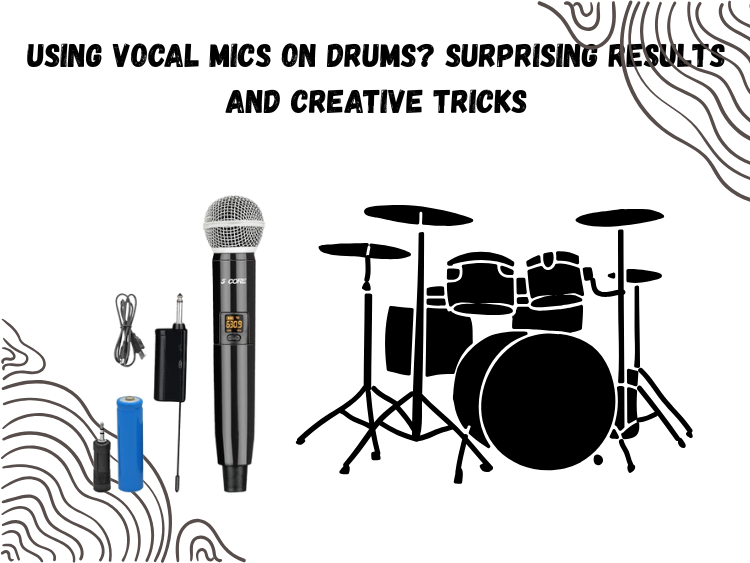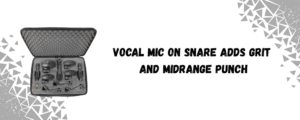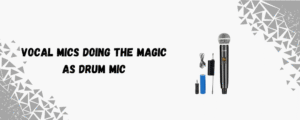When someone drops a vocal mic in front of a snare drum, the instinct is to cringe. After all, we’ve been conditioned to believe drum mics and vocal mics serve separate purposes—and that crossing those wires is amateur hour.
But here’s the thing: rules are great until they get in the way of great sound.
Vocal mics on drums? Turns out, it’s not just possible—it’s downright useful. If you know what you’re doing, they can unlock gritty, immediate tones that traditional drum mics don’t always deliver.
Let’s break it down.
1. Why Even Bother Using Vocal Mics on Drums?
The logic seems simple: vocal mics are tuned for the human voice—midrange-focused, designed to minimize plosives and pick up subtle nuance.
Drums, on the other hand, are explosive, dynamic, and full of transient energy.
But that mismatch can be a creative advantage. Especially when you’re after something raw, aggressive, or unconventional. Vocal mics bring a unique flavor to the table:
- Tight proximity response
- Solid off-axis rejection
- Built-in compression-like behavior
- Coloration that adds grit
You’re not using them to perfectly capture drums—you’re using them to shape how those drums feel in a mix.
2. The Snare Drum Trick Everyone Overlooks
Here’s a quick experiment: throw a standard cardioid vocal mic on your snare. Not a fancy overhead—just a regular handheld dynamic.
That midrange-forward character that flatters a singer’s voice? It translates beautifully into snare body and crack. The tight pickup pattern keeps hi-hats in check, and if you angle it right, you can almost fake the gated 80s snare sound—no plugin needed.
Even better, layer this with a traditional snare mic (like the one from the 5 Core 7-Piece Drum Mic Kit) and blend to taste. One gives you punch, the other gives you vibe.
Interestingly, 5 Core even provides great discounts to business owners if you’re buying in bulk. Refer to this site for more information. Here’s also a one-stop platform where you can find all their products.
3. Vocals With Bite, Not Boom
Vocal mics as drum mics are hit-or-miss—but when they hit, it’s magic. The natural roll-off on most vocal mics tames muddy lows, while the slightly boosted presence range helps the mics cut through busy guitars or synths.
Use this when you’re working with tight kits or low ceilings—where bleeding cymbals and reflections make traditional tom miking tough.
Pair that with a directional setup, and suddenly your floor tom doesn’t sound like it’s drowning in overhead spill.
4. Overheads? Only If You’re Bold
Now for the disclaimer: using vocal mics as overheads is not for the faint of heart.
You’re dealing with fast transients and wide stereo spread. Vocal mics generally aren’t tuned for this and lack the frequency response to capture shimmery cymbals the way condenser overheads do.
But here’s where it gets weird—in a good way.
If you’re chasing a lo-fi, vintage, or garage-rock vibe, a pair of dynamic vocal mics overhead can give you the exact character you’re after. Think of them as texture mics, not accuracy tools.
Want a practical setup? Place one vocal mic just above the rack tom aimed at the snare, and another near the floor tom angled toward the ride. Mono-ish overhead sound, zero harshness, total control.
5. Bleed Isn’t Always a Bad Thing
One of the main reasons people avoid vocal mics on drums is bleed. But that mindset can be limiting.
Sometimes, you want bleed. You want the room, the cymbal wash, the ghost notes, the pedal squeaks. These elements bring life to a recording. And vocal mics, with their tailored off-axis response, capture bleed in a musically useful way.
Use them as room mics up close—not far away. You’ll get a focused, colored image of the whole kit, full of imperfections that sound intentional.
6. Let Your Mix Do the Polishing
Here’s where creative recording techniques really shine. Using vocal mics on drums isn’t about getting a pristine take straight off the preamp. It’s about printing color that you can shape later.
Use EQ to tighten the low end. Use saturation to add weight. Use a multiband compressor to tame the midrange if needed.
That slightly nasal snare tone? Flip it into a strength by shaping it around the vocal range or carving space in a crowded mix.
You’re not fixing problems—you’re committing to character.
7. When to Stick With Purpose-Built Drum Mics
As fun and flexible as vocal mics can be, sometimes the job calls for something dialed in. Like when you’re recording full band takes in a treated room and need each mic to do exactly what it’s meant to.
This is where kits like the Shure PGA Drum Mic Kit or the rugged, no-nonsense 5 Core dynamic mic bundle come into play. You’ll get the isolation, consistency, and tonal range needed for commercial-ready drum recordings—especially in complex setups or live gigs.
Final Thoughts
Rules are made to be broken—but only when you understand why they exist in the first place. Swapping in a vocal mic for a snare mic isn’t going to win any studio purist awards, but it might just land you a drum tone that feels more real than any polished preset.
In a world full of cookie-cutter samples and perfectly EQ’d overheads, sometimes the best way to stand out is by reaching for the wrong mic… on purpose.
Let it be messy. Let it be noisy. Let it be yours.




